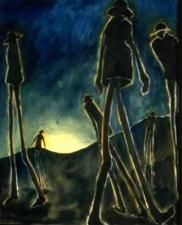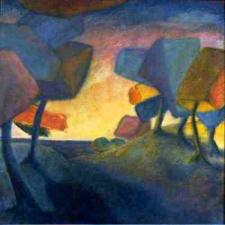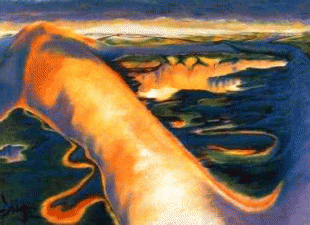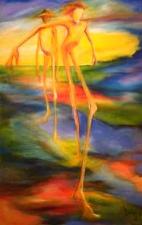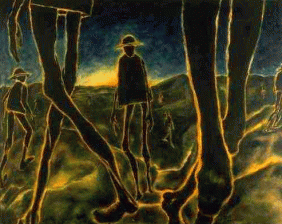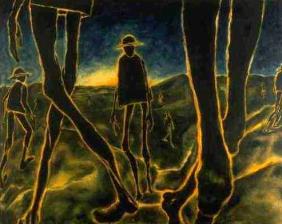Della Heywood
Biography
http://dellaheywood.com/?page_id=19 From 1997:
Born in Vancouver, Della’s primary interest from early childhood was art. She attended the Emily Carr School of Art and Capilano College where she studied a variety of artistic mediums. In her development as an artist, Della was influenced by the Impressionists, Post-Impressionists and the Surrealists. This is revealed in her love of light, intensity of colour and appreciation for dream-like realities. Her paintings document her quest to strip away habitual cognition and enter into the magical world behind and within ordinary perception. Della currently lives in California and has become one of the most accomplished members of the School of Reductionism.
SCHOOL OF REDUCTIONISM
Conceived in 1987 by E.J. Gold, a prominent American artist, and other members of the Grass Valley Graphics Group, an artist's community in northern California. The School consists of more than 20 American and Canadian painters and sculptors who have worked with Gold to reformulate the aims and principles of contemporary visual art.
Reductionism embodies both a philosophy of art and certain practical principles which infuse its works with recognizable qualities.
The philosophy of Reductionism places utmost value on the creative act which originates as an aesthetic perception and a corresponding state or condition of being. It is then the artist's task to capture or express this perception in a work of art which enables the viewer to have the same experience. Reductionist art is therefore objective in nature and not an exploration of the subjective states of the artist.
Artists of the School include: E.J. Gold, Della Heywood, Kelly Rivera, Heather Valencia, Stephanie Boyd, Menlo Macfarlane, Robbert Trice, Tom X., Claude Needham, Zoe Alowan, Richard Hart, Mark Einert, Douglass-Truth, Yanesh, Lidy Nova, Joe Alowan, Tim Elston, David Christie and more.
Although Reductionism in practice is broadly inclusive, experimental and evolving, its art is nonetheless often characterized by three basic qualities:
Essentialism
Reductionism uses recognizable objects and is therefore representational. However, objects are important for their effect, not important in themselves. The artist attempts to achieve an effect with the fewest possible lines and details, removing extraneous elements which may deviate or obscure the effect...thus the name Reductionism. Objects are reduced to their essentials in a move toward the abstract. Similarly, colour is used unambiguously and powerfully to enhance its effect. Colours are few, vibrant, sharply contrasting.
Timelessness
Reductionism typically explores another dimension of time, a dimension which is not sequential or "horizontal" but eternal or "vertical"...the same dimension of time which contains the creative act itself. There is little or no explicit movement in Reductionist art. Nothing is happening in the usual sense and time, therefore, does not pass. The result is an enhanced awareness of posture, positioning of visual elements and their inter-relationships. Freezing the frame, rendering objects static, also has the effect of freeing other forms of movement such as feeling...motion through emotion.
Space
Perhaps the outstanding feature of Reductionist art is that, despite a limited use of the techniques of perspective to create three dimensional effects within the picture, the art nonetheless establishes a sense of space. The reason is the primary place assigned to the viewer. Because the Reductionist artist strives for communication, scenes are composed for a viewer who is not a voyeur outside the scene but rather a participant who is the reason for the work and necessarily a part of it. Everything in the scene is oriented first and foremost to the viewer so as to bring the viewer into a relationship with it. Depth of field is therefore not bounded by the frame but includes the viewer in a truly three dimensional experience of space. Thus, the art is only completed by viewing.

